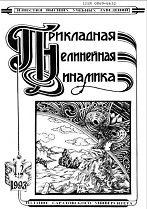|
APPLIED PROBLEMS OF NONLINEAR OSCILLATION AND WAVE THEORY
Interaction of electromagnetic radiation with biological objects and social systems
A. S. Dmitriev, A. I. Ryzhov
Kotelnikov Institute of Radioengineering and Electronics
of Russian Academy of Sciences, Moscow, Russia
Abstract:
Popularisation of the key scientific problems occupied a significant place in D. I. Trubetskov's work. In memory of this fact, the problem of electromagnetic field affecting biological objects is discussed in a popular manner in this article. This problem has more than a century in it's history, but still being far from the final solution. Objectives. Analyze the problem of the interaction of electromagnetic fields with biological objects and social structures as complex multielement systems, and assess the possibility of identifying new effects in their behavior. Methods. As a result of many studies in different countries, by the mid-60s of the twentieth century, an idea was formed about the complex and systemic nature of the influence of electromagnetic fields on biological objects. Therefore, the interaction of electromagnetic fields with biological objects and social environments is considered in the work as a problem of external influence on complex multielement interconnected systems, using conceptual approaches of nonlinear dynamics. Results. It is shown that along with the effects of EMF on individual biological objects, there are effects of the influence of the information component of EMF on social systems, the elements of which are people considering as biological objects. The threshold power flux density where the influence effects on the social systems begin to manifest is significantly lower than the one for biological objects. Conclusion. Effective approaches aimed to reduce the negative impact of microwave radiation on humans can be implemented using personal means for monitoring the level and the received dose of radiation - electromagnetic radiation dosimeters, which are actually analogous to thermometers for measuring body temperature.
Keywords:
electromagnetic field, biological objects, mobile communication systems.
Received: 30.04.2021
Citation:
A. S. Dmitriev, A. I. Ryzhov, “Interaction of electromagnetic radiation with biological objects and social systems”, Izvestiya VUZ. Applied Nonlinear Dynamics, 29:4 (2021), 549–558
Linking options:
https://www.mathnet.ru/eng/ivp434 https://www.mathnet.ru/eng/ivp/v29/i4/p549
|

| Statistics & downloads: |
| Abstract page: | 135 | | Full-text PDF : | 99 |
|




 Contact us:
Contact us: Terms of Use
Terms of Use
 Registration to the website
Registration to the website Logotypes
Logotypes








 Citation in format
Citation in format 